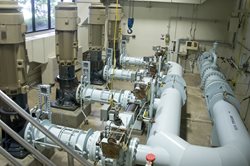Data acquisition and database connectivity
For data acquisition applications, choose a PAC system with two strengths: first, substantial memory for acquiring and storing data; and second, the ability to
share data directly with corporate databases over an Ethernet network.

If control networks and computer networks need to be separated, consider how you'll accomplish this. One way is to segmented networking using independent Ethernet network interfaces on the PAC itself.
Operator Interface
Check out the PAC-based system's human-machine interface (HMI) options. The integrated software development environment should use a single tagname database, so that once you define variables and I/O in the control software, you can immediately use them in the HMI software.
A PAC should also offer communication with third-party HMIs using OPC. And other options, such as a touchscreen terminal, may be available as well.
Future expansion
Plan for the future. When your needs change, additional distributed I/O can be handled by the same PAC—as can process, discrete, and motion control. All of these types of control should be programmable in the same software as part of the same system, and most changes should require no middleware or add-ons.